Medical Students Make Connections Over Community-Based Learning
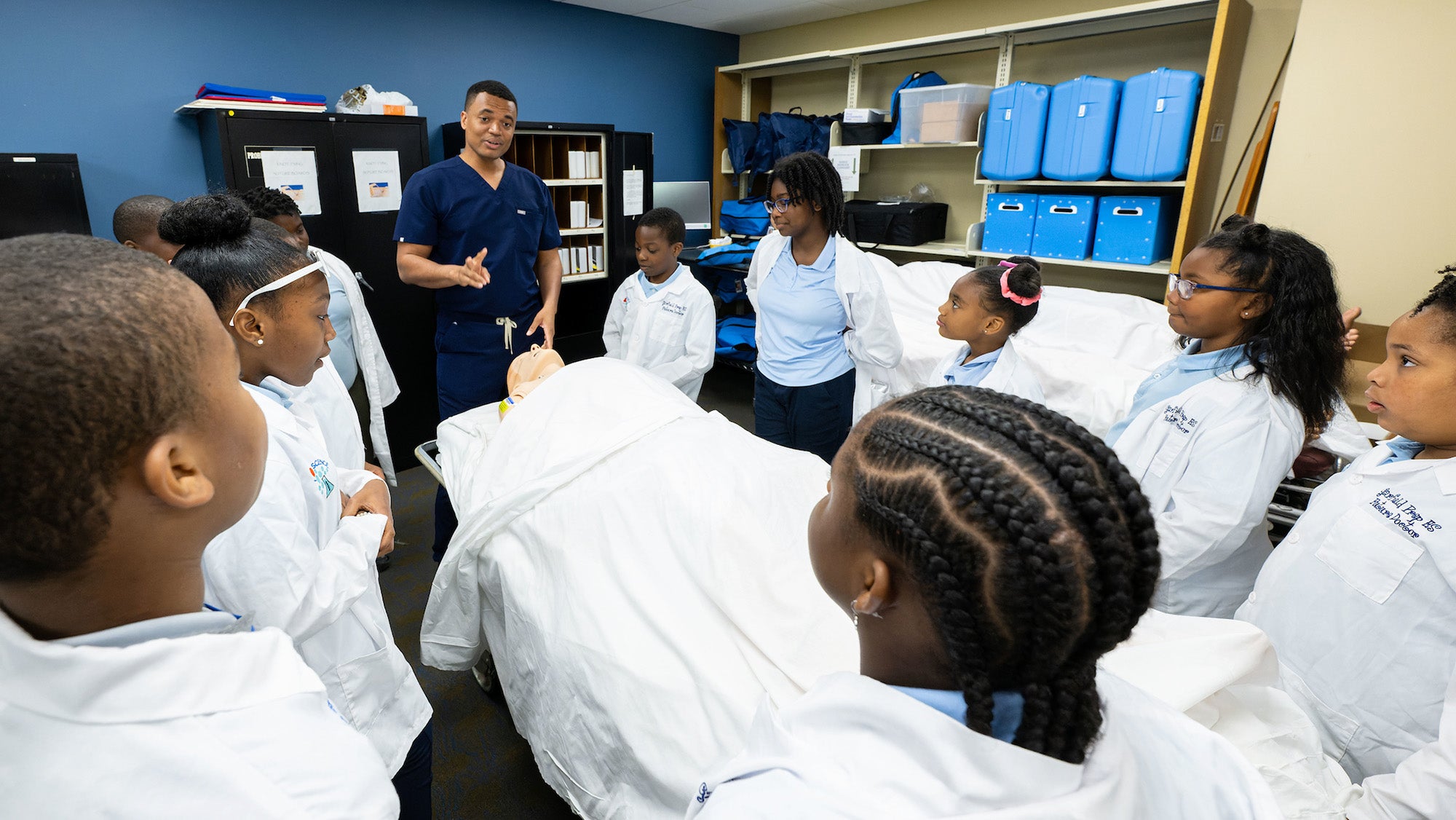
Posted in News Stories | Tagged community outreach, community-based learning, health disparities, health equity, service to others, student experience
(April 30, 2023) — A medical trivia Easter egg hunt, a visit to the simulation lab and a campus tour were among the activities medical students organized as part of a School of Medicine visit for a group of fourth grade students from a local elementary school.
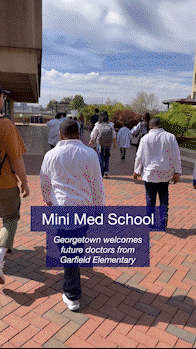
The April 14 visit came at the end of the community-based learning (CBL) course, a class that gets first-year medical students out of the classroom and into one of 24 community sites, serving children, adolescents or older people, as well as people experiencing housing or food insecurity, in supportive housing or living with disabilities.
Twenty medical students chose Garfield Elementary as their CBL site this year, making the Title I school in southeast Washington, D.C., the most popular location for the course. “Garfield is a strong partner with enthusiastic students who choose to be a part of the mini med school program there, so it’s hard to not feel the consistent excitement about their team!” said Margaret Eshleman, MEd, community-based learning education coordinator.
As a former teacher and aspiring pediatrician, Joshua Deklotz (M’26) chose Garfield as his CBL site because he felt comfortable with the setting. “Working with the kids at Garfield reminded me of how meaningful it is to teach and mentor the youth in my own community,” he said. “I was extremely excited to work with the same population that I want to serve medically as well.”
“My goal was to inspire and motivate the students of Garfield Elementary School to believe that they too, irrespective of their backgrounds, have a place in medicine, higher education and beyond,” said Perry Diaz (M’26). “Working with school groups always provides a unique sense of purpose and responsibility since it gives you the opportunity to impart some tangible skills on a great group of children who will value and pass on the skill set.”
‘We Need You in Medicine’
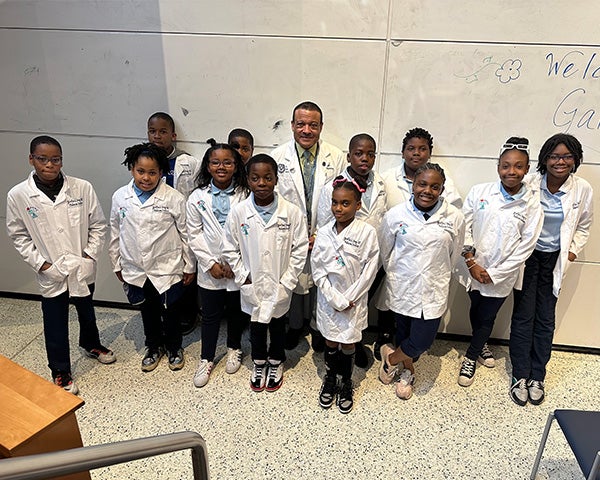
Donning their own white coats, the fourth graders started the morning in W. Proctor Harvey Amphitheater in the Medical-Dental Building with a welcome from Lee Jones, MD, dean for medical education.
“Medicine is growing all the time, and we always need help with how to get better,” he said. “So one of the reasons I’m so excited to be here to talk with you is we need you in medicine. We need people with new ideas, we need people with ideas about how to make things better from what they’ve been experiencing.
“When I talk to a number of students here who look like you and me, including myself, many times, people told me, maybe you shouldn’t think about medicine, maybe you should think about something else,” Jones added. “And I chose not to listen to those people and I found people that supported me and believed in me.”
Jones encouraged the students to hold onto their dreams and find people who support them. “It’s your life,” he said. You get to live it. It’s really important to hold on to your dreams.”
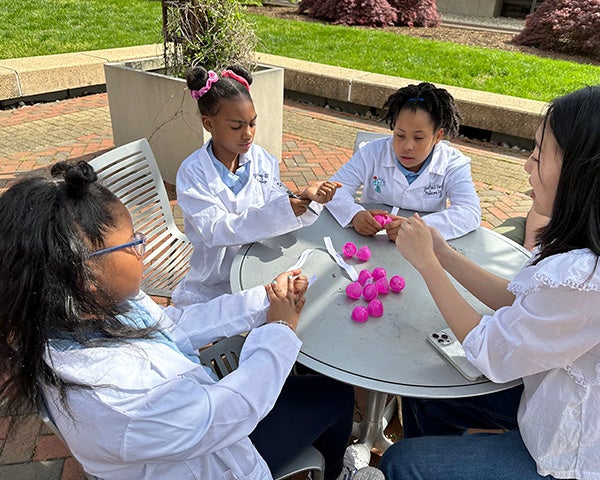
Learning to Save Lives
Under the pergola on the podium, students split into teams to hunt for Easter eggs stuffed with medical trivia questions, including a special golden egg worth double points.
“Where is it? Give us a hint!” a fourth grader asked. “I would look on the ground,” a medical student replied. Moments later, a girl with white sunglasses perched on her head happily ran across the grass, holding the golden egg.
Medical students helped the fourth graders answer the questions in the eggs. “What type of cell helps fight off germs?” a child in a white coat asked. “What is it? The sophagus?” another fourth grader said, attempting to answer a question.
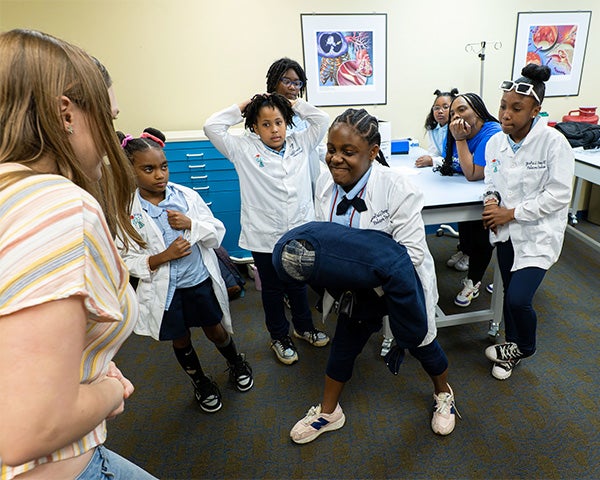
After a brief walk around campus and lunch, the fourth graders visited the simulation center to learn how to perform the Heimlich maneuver with a dummy wearing a Georgetown sweatshirt. “Hold your hand in front of your fist like you’re Captain America holding a shield,” said Emily Katz (M’26). “Don’t be afraid to push hard. Don’t be afraid to hurt the person.”
On the other side of the room, medical students talked with the fourth graders about the location and function of different organ systems. The fourth graders then split into two teams, competing to quickly and accurately place the organs on dummies. “You might want to pay attention,” Diaz said. “There are prizes at stake.”
When they finished playing games and learning to save lives with the Heimlich maneuver, the fourth graders put together plastic stethoscopes and talked with the medical students.
“What was your favorite part of the day?” Diaz asked. “Everything,” a fourth grader replied.
Learning Lessons for the Future
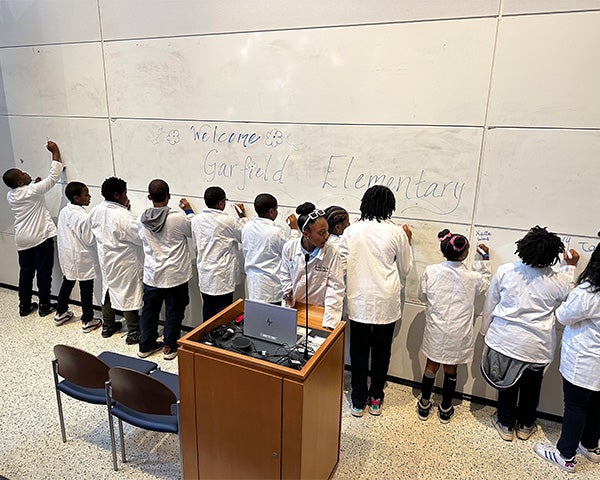
Diaz was impressed by how quickly the students picked up the material he taught them. “I only needed to formally show a few students the lesson plan before they all started working amongst themselves to share the information in a way that they know their classmates understand,” he said. “I listened to one young girl explain to another some functions of the liver, without missing a detail, after hearing the information only once before.”
The CBL course was an opportunity for Deklotz to practice communicating with an audience he will serve as a pediatrician in the future. “Through the process of developing a curriculum and presenting it to the kids, I learned a lot of valuable ways to communicate about health, wellness and medicine to a young audience,” he said.
“I also gained valuable insight, through conversations and research with other medical students in my group, about some of the major social determinants that contribute to the health and wellness of the students at Garfield and their community,” Deklotz added. “I also hope to use these insights going forward in my own medical practice.”
Kat Zambon
GUMC Communications
